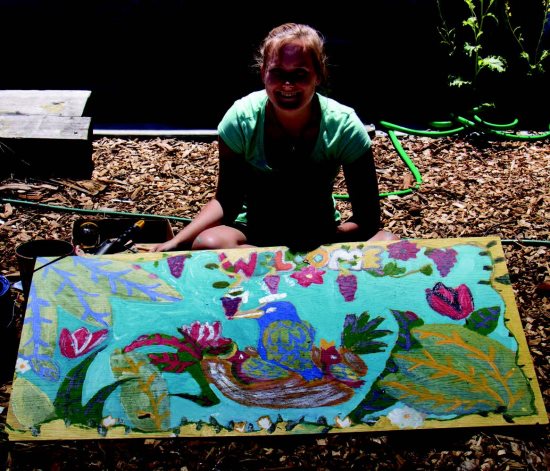
| ||||||
Why is this knowledge important? A report by Bayer Global estimates that "by the middle of the century, the demand for agricultural products will be 50 percent higher than in 2013, while at the same time, the amount of U.S. farmland is decreasing." The USDA reports that 6.6 million acres were lost from 2008-15, and the amount continues to decline.
When these students approach middle age, how will they feed themselves? The answers may be in what they learn through their garden projects.
Helping with these efforts is the Global Student Embassy, a nonprofit group. Kelsey Ring, an educator with GSE, coordinates the AUHSD gardens, leading the students in activities that connect the gardens with global environmental issues (Las Lomas also has a garden, but is not in our Lamorinda circulation area).
GSE promotes cultural exchange with Latin American countries. Over spring break, nine students from Campolindo traveled with Spanish teacher Concepcion Martinez to Nicaragua and learned how to work with a farming group dealing with soil destroyed by growing cotton. One Miramonte student traveled to Ecuador. Students from Ecuador and Nicaragua also visit the U.S. to support local projects.
Miramonte
First-year science teacher Chrissie Orangio runs the garden in connection with a semester-long Horticulture class. "One of the chief goals is to create outdoor spaces so students can learn outside of the classroom," she says. Her class is asked to design a space based on community needs and to learn how to grow food in a small amount of space.
Orangio is no stranger to global environmental concerns, having worked in South Africa and as a GSE coordinator.
The first semester class created an outdoor classroom where a previous garden struggled to take shape. They added several fruit trees to the ones already there, trimmed the grape vines and other established plants, and built benches to allow classes to use the space.
The spring semester task is to build one piece of a mindfulness garden that will leave a mark on the school. Some ideas include art and murals in the garden, learning about herbs and medicinal uses of plants, and a zen garden. The group is also adding a greenhouse in the near future.
A drawback is lack of signups for next year's Horticulture class. "The class was canceled," says Orangio, "but the Garden Club will continue running it after school and weekends, along with GSE."
Campolindo
Although Campolindo doesn't have a class responsible for the garden, science teacher and advisor Jane Kelson says, "Of the four high schools in the district, we have the most active and largest club." Fellow science teachers Tren Kauzer and Roxanna Jackman help out.
They meet at lunch and after school on Thursdays, with a main core of 10-20 students. Unlike the others, their garden area is separated from the campus by the large student parking lot.
"It's therapeutic for them to be in the garden," says Kelson. "It gets them off their phones and talking while working. Some great conversations happen out here."
Seedlings grow in the greenhouse donated by the Rotary Club, and an aquaponic system will soon be installed. The group grew fava beans over the winter and then ground them up into a nitrogen-rich amendment for the raised beds.
Kelson, a veteran teacher, speaks enthusiastically about the program: "We love it. It's the students' space. We're less worried about a perfect garden than a perfect learning place."
The garden is student-run and designed. A pair of students particularly stand out: Kelsey Levante helped write and obtain a grant from Allied Waste, and John Stepp built raised beds as part of his Eagle Scout project. The club's efforts with recycling - their three-bin system greatly increased the diversion rate from 6 to 38 percent - won prize money from the AUHSD.
Acalanes
James Poling, a first-year science teacher at AHS, inherited the garden project and the Environmental Science class that would use it as their "lab." Poling, a Miramonte grad, has a bachelor's degree in biology, with a minor in chemistry from UC Davis.
The raised beds were in disrepair and gophers had invaded the garden area. "I want to return the garden to its former glory," says Poling. "I'm proud of us rebuilding seven raised beds so far with recycled wood and solving the rodent problem with gopher wire."
Poling has a small but active group of students, and is looking for other people willing to help, mentioning Girl Scouts and Eagle Scouts and looking to the Lafayette Masters Gardening Association.
"I'm optimistic about where we're going, but realistic about this being a rebuilding year," admits Poling. "I'm happy to be here and look forward to harvesting food to donate to the Food Bank."
Jessica Glover, a student in the Environmental Science class, said, "I like getting outside and enjoy learning how plants grow." She hopes to do a garden at home with her father.
Perhaps this is the solution for the future: Growing a garden with your family using methods learned in your high school curriculum.

Reach the reporter at:
